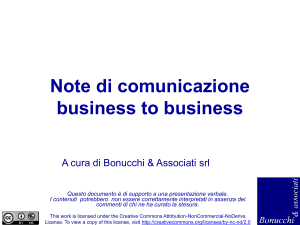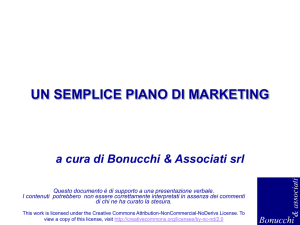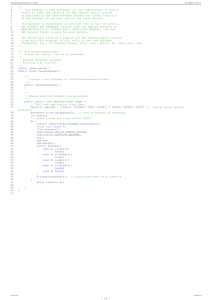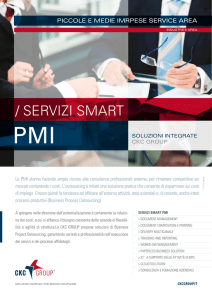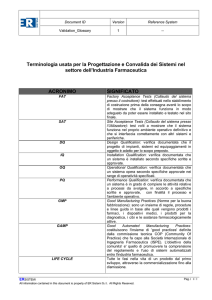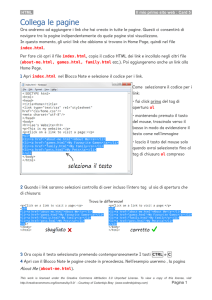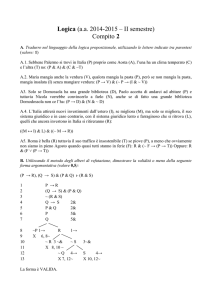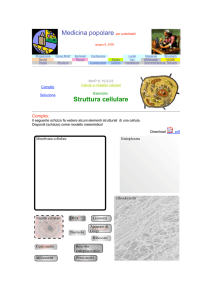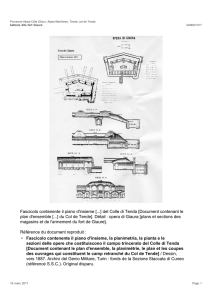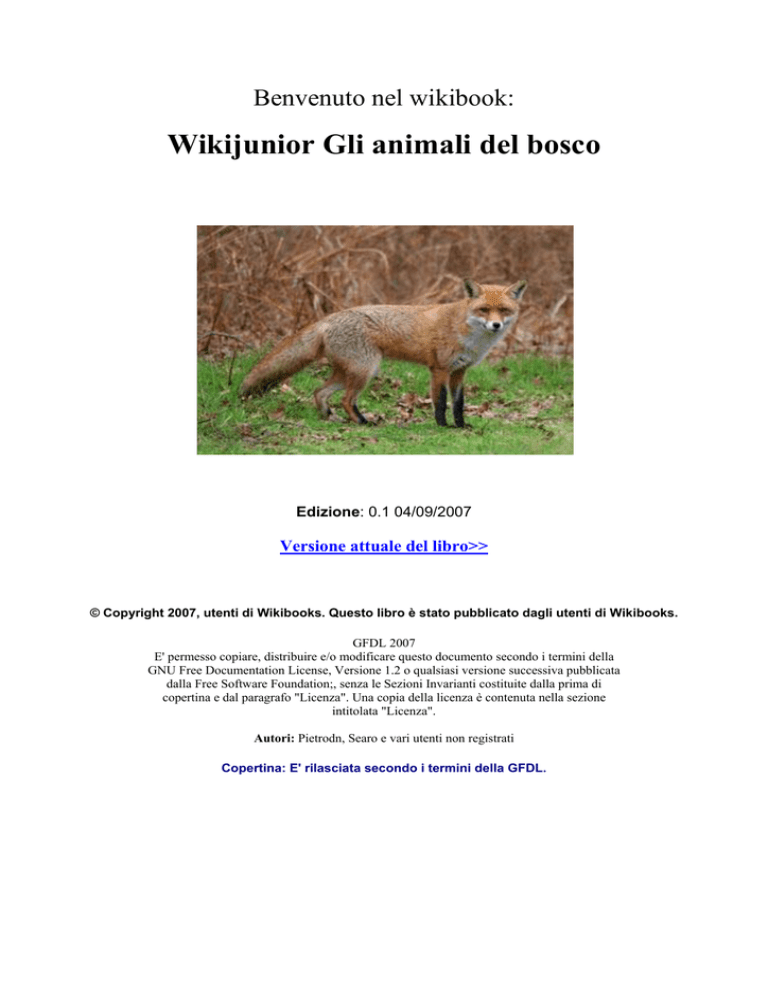
Benvenuto nel wikibook:
Wikijunior Gli animali del bosco
Edizione: 0.1 04/09/2007
Versione attuale del libro>>
© Copyright 2007, utenti di Wikibooks. Questo libro è stato pubblicato dagli utenti di Wikibooks.
GFDL 2007
E' permesso copiare, distribuire e/o modificare questo documento secondo i termini della
GNU Free Documentation License, Versione 1.2 o qualsiasi versione successiva pubblicata
dalla Free Software Foundation;, senza le Sezioni Invarianti costituite dalla prima di
copertina e dal paragrafo "Licenza". Una copia della licenza è contenuta nella sezione
intitolata "Licenza".
Autori: Pietrodn, Searo e vari utenti non registrati
Copertina: E' rilasciata secondo i termini della GFDL.
Indice generale
Sommario Il gufo ............................................................................................................................................... 2 Il cervo ............................................................................................................................................. 3 Il pipistrello ...................................................................................................................................... 4 Lo scoiattolo.................................................................................................................................... 5 Il tasso.............................................................................................................................................. 5 Il camoscio ...................................................................................................................................... 6 La volpe ........................................................................................................................................... 7 L’aspide ........................................................................................................................................... 8 La talpa ............................................................................................................................................ 8 L’ermellino ....................................................................................................................................... 9 Il lupo ............................................................................................................................................. 10 Il grifone ......................................................................................................................................... 11 La salamandra ............................................................................................................................... 11 Il ghiro ............................................................................................................................................ 12 La lince........................................................................................................................................... 12 Il cincillà ......................................................................................................................................... 13 Il marasso ...................................................................................................................................... 14 Licenza ........................................................................................................................................... 14 Il gufo
Com’è fatto?
Il gufo reale ha grandi dimensioni. Ha fino a 181 centimetri di
apertura alare, pesa quasi 3 chilogrammi e misura anche 70
centimetri di lunghezza. Il gufo comune o selvatico è un rapace
notturno lungo 35 centimetri con un'apertura alare tra gli 87 e i 94
centimetri. È caratterizzato da occhi di colore giallo arancio e da due
vistosi ciuffi. I gufi sono uccelli che hanno capo tondeggiante occhi
frontali piumino ricco e folto e abitudini notturne. Il maschio del
gufo reale misura 65-70 centimetri.
Dove vive?
Il gufo reale vive nei boschi con scarpate rocciose. I gufi vivono nei
nostri boschi e in Europa in Nuova Zelanda, Australia, Nuova Guinea meridionale e nelle piccole
isole della Sonda. È molto diffuso in Nuova Zelanda e in Australia. Il suo nido può essere fatto
anche in un anfratto roccioso, molto raramente sul terreno. Il gufo comune vive di preferenza nelle
foreste di conifere e nei boschi misti alternati a zone aperte dove occupa cavità d'alberi.
Cosa mangia?
Gli piacciono anche gli insetti, farfalle notturne, i ragni, le lucertole, gli uccellini, i ratti e i topi.
Come si riproduce?
La femmina depone 3-4 uova bianche e rotonde (verso mezzo aprile) in un nido nel cavo di un
albero nascosto nella densa vegetazione. Comincia la cova di 30 - 31 giorni dopo la deposizione del
primo uovo e depone le altre uova a intervalli di 2 giorni. I piccoli restano nel nido per circa 3
settimane, protetti e nutriti da entrambi i genitori.
Quali sono le sue abitudini?
I gufi cacciano di notte hanno una vista molto acuta e sono estremamente silenziosi.
Il cervo
Com’è fatto?
Il cervo è un mammifero che ha 2 corna, 4 zampe e può raggiungere
la lunghezza di 1,90 m e il peso di 150 kg. Una caratteristica molto
curiosa è che il cervo perde ogni anno le corna. Esse ricresceranno
nell'identica forma e posizione dell'anno precedente ma con una
ramificazione in più. Assai diverso è il peso che possono
raggiungere le corna. Negli individui più deboli pesano 9-10 kg ma nei più robusti possono pesare
16-18 kg. Ogni anno queste corna perdono ramificazioni ma ogni anno ne crescono di nuove. Ecco
perché questi animali hanno bisogno di un'alimentazione tanto ricca di calcio: più il cervo è debole
più le sue corna crescono fragili. Particolare curioso: quando un animale si ferisce la parte inferiore
della zampa destra o sul bordo dello zoccolo, le sue corna crescono molto meno da quel lato.
Dove vive?
Il cervo vive in Europa, in America e in Africa settentrionale e si vede raramente perché è molto
timido e pauroso. Il cervo non abbandona mai il posto dove si è abituato a vivere.
Cosa mangia?
Il cervo è erbivoro mangia erba, foglie, cespugli e la corteccia della robinia. Il cervo adulto mangia
la quercia.
Come si riproduce?
La cerva cerca un luogo riparato per accogliere i suoi piccoli. Si sistema possibilmente in boschi
riparati o in tane scavate dai maschi con le corna. Partorisce un cucciolo alla volta. Quando il
piccolo è nato la mamma lo lecca tutto. Quando il piccolo cervo ha un anno il più grande se ne va.
Quali sono le sue abitudini?
Al cervo piace togliere la corteccia dai tronchi o fare buchi dappertutto.
Quali sono i suoi nemici?
I nemici del cervo sono: l'orso, il lupo, la volpe. Viene cacciato anche dall'uomo perché la sua pelle
è pregiata e la sua carne è buona.
Il pipistrello
Com’è fatto?
Il pipistrello sembra un topo con le ali. Esse si chiamano membrana alare o patagio ed è una pelle
che congiunge le dita delle sue mani. Le sue zampe hanno 5 artigli che gli servono per appendersi ai
rami durante le soste. Questi artigli sono le sue unghie.
Dove vive?
La maggior parte delle specie vive in Europa. Il pipistrello vive nei luoghi oscuri e nei solai e nelle
cantine. Spesso i pipistrelli vivono anche nelle caverne.
Cosa mangia?
Il pipistrello mangia la frutta e molti insetti (200 - 300 per sera per lo più moscerini).
Come si riproduce?
Gli accoppiamenti avvengono alla fine della stagione estiva ma i piccoli nascono alla fine della
stagione primaverile. Le femmine si raggruppano a 10 a 10 fino ad arrivare a 100 e allevano i loro
piccoli lontano dai maschi.
Quali sono le sue abitudini?
Il pipistrello va a caccia di sera per catturare insetti e cercare frutta.
Quali sono i suoi nemici?
I rapaci notturni, le altre specie di pipistrelli e tutti i veleni che l'uomo utilizza nell'agricoltura
perché avvelenano gli insetti dei quali si nutre.
Lo scoiattolo
Com’è fatto?
Lo scoiattolo è il più noto e simpatico tra i roditori
europei. Ha dimensioni medie. La sua lunghezza
varia da 35-45 cm., di cui 15-20 di coda! Pesa da
230 - 450 g. Ha un corpo agile e slanciato. La
colorazione del pelo è molto variabile e va dal
rossiccio al marrone scuro o quasi grigio. In
inverno l'estremità delle sue orecchie presenta dei
tipici ciuffi di pelo. I suoi arti inferiori sono molto
potenti e gli permettono di fare dei salti molto lunghi. Grazie alle sue unghie molto robuste riesce ad
arrampicarsi con molta facilità.
Cosa mangia?
Lo scoiattolo mangia le pigne i funghi, bacche, ghiande. Gli scoiattoli se trovano i semi di girasole
li mangiano.
Come si riproduce?
Lo scoiattolo si riproduce ad un anno di età. Ha 38 giorni di
gestazione e nascono per 2 o 4 volte al anno.
Quali sono le sue abitudini?
E un animale diurno, si arrampica e salta con abilità sugli alberi, su cui vive nonostante rapide
escursioni sul terreno alla ricerca del cibo. Si ciba di semi, noci, bacche, funghi, gemme e a volte di
nidiacei.
Quali sono i suoi nemici?
I suoi nemici sono il falco, la volpe, il gufo e il serpente.
Il tasso
Com’è fatto?
Il tasso ha tanti peli e ha delle strisce nere e bianche. Il tasso scava delle gallerie profonde.
Dove vive?
Il tasso a volte vive in piccoli gruppi familiari. Di notte va e cercare il cibo e passa il giorno in un
ampia e comoda tana sottoterra.
Cosa mangia?
Il tasso mangia lombrichi, prugne, ciliegie, ricci, ghiande, noci e noccioline.
Come si riproduce?
Il piccolo del tasso sta dentro la pancia della mamma da sei fino a dodici mesi. Nascono 4 piccoli
per volta.
Quali sono le sue abitudini?
Il tasso scava gallerie profonde e va in giro di notte.
Quali sono i suoi nemici?
Il tasso ha come nemici la volpe, il serpente e l'aquila.
Il camoscio
Com’è fatto?
Il corpo del camoscio è perfettamente adattato al suo ambiente. Le
sue zampe robuste e muscolose e il passo molto lungo, perché è
privo di clavicole, gli consentono di saltare con grande facilità sulle
pareti rocciose delle vette. Inoltre la conformazione particolare degli
arti e la disposizione obliqua delle scapole procura un effetto molla.
Dove vive?
Il camoscio vive in Europa. Tra gli 800 e i 2300 metri d'altezza. Il camoscio in particolare dei
Pirenei vive in branchi.
Cosa mangia?
Il regime alimentare del camoscio è basato sull'erba ma la sua dieta varia a differenza delle piante
da una stagione all'altra, da un'anno all'altro. Predilige le piante erbacee e in particolare le
graminacee e il tasso. Durante la stagione estiva il camoscio mangia anche erica, muschio, licheni.
Come si riproduce?
La femmina del camoscio mette al mondo un solo cucciolo all'anno tra maggio e giugno dopo 23,
25 settimane di gestazione. Tuttavia se questo è un maschio, quasi sempre sceglie di rimanere nel
branchi dei giovani. Il piccolo non si allontana dalla mamma che per qualche settimana si dimostra
molto protettiva nei confronti del piccolo.
Quali sono i suoi nemici?
I suoi nemici sono: il lupo, l'aquila, il cacciatore, i cani da caccia, le valanghe, la volpe e la lince.
La volpe
Com’è fatta?
Le volpi più grandi sono lunghe da 82/90 cm mentre le più piccole
misurano fino a 50/90 cm. L'altezza alla spalla è di 35/40 cm. La
coda è lunga 35 cm. Il colore della parte superiore è bruno e
arancione e la parte inferiore è biancastra.
Dove vive?
La volpe vive nei boschi e sulle montagne nei prati nelle città e spesso nei paesi. La volpe ruba la
tana ai tassi. È diffusa in Europa dove vive fino a 2800 metri d'altezza.
Cosa mangia?
La volpe è un carnivoro che mangia prede spesso deboli: galline e
piccoli animali del bosco. Mangia anche rifiuti organici (scarti) per
esempio bucce di banana, semi che noi non mangiamo ecc…
Mangia il fagiano se riesce a catturarlo. Il piccolo di volpe non
mangia carne subito dopo la nascita ma succhia il latte dalle
mammelle della sua mamma.
Come si riproduce?
La femmina della volpe probabilmente ha più maschi. Il parto avviene dopo 9 settimane e possono
nascere fino 12 piccoli, ma di regola sono 4 o 5.
Quali sono le sue abitudini?
Ci sono molte leggende attorno alla volpe e alla sua proverbiale furbizia. Sarà leggenda o realtà che
se è presa in trappola, si finge morta e fugge appena si libera? Che per attirare un corvo si finge
morta e poi gli salta addosso? Che scaccia il tasso dalla sua tana depositando i propri escrementi
all`entrata? Che pesca i gamberi uscendo dall`acqua dopo essersi fatta pizzicare. Si dice che la
volpe può mangiare i ricci con un sistema furbissimo. Quando il riccio si appallottola ci urina sopra.
Il riccio per non soffocare si apre perché deve respirare e lei lo mangia evitando di farsi pungere
dagli aculei. In realtà sembra che la volpe non sia proprio un animale così intelligente.
Quali sono i suoi nemici?
I nemici della volpe sono gli orsi, gli uomini e altri animali più grandi di lei.
L’aspide
Com’è fatta?
La Vipera aspis è una delle circa 60 specie di vipere esistenti in
Europa. Non è molto lunga, misura da 50 a 60 cm. e ha la testa
triangolare con una V rovesciata sopra. Ha una colorazione variabile.
Ha il dorso che può essere da marrone rossiccio a quasi nero. Il
ventre è invece bianco giallognolo.
Dove vive?
E diffusa in tutta l'Europa mediterranea ma è rintracciabile perfino alle latitudini della Svezia. La si
trova specialmente nelle zone sassose e secche. In montagna è presente fino a 3.000 metri.
Cosa mangia?
Mangia: topi, talpe, ghiri e piccoli animali.
Come si riproduce?
Fa le uova e dopo quattro mesi nascono i piccoli. Ne fa da 2 a 12.
Quali sono le sue abitudini?
L'aspide è calma e pigra. Non le piace essere disturbata e se non riesce a fuggire può mordere. Il suo
morso è velenoso ma solo raramente mortale.
Quali sono i suoi nemici?
L'aspide è cacciata dai tassi, dai rapaci, dall'uomo, dal riccio, dalla volpe e dalle donnole.
La talpa
Com’è fatta?
La talpa è tutta nera e ha 4 zampe. Ha il pelo molto corto e molto
fitto. Il suo muso è lungo e gli occhi sono talmente nascosti dal pelo
che non le permettono di vedere quasi niente. Il suo corpo è lungo da
12 a 14 cm mentre la coda è lunga 3 cm.
Dove vive?
La talpa vive sotto terra nei campi e nei giardini in Europa, Asia e anche in America. I mucchi di
terra che fa sono formati dalla terra che butta fuori con le sue zampette.
Cosa mangia?
La talpa si nutre di larve, vermi, moscerini e di tante altre cose che trova sotto terra.
Come si riproduce?
I maschi sono sempre alla ricerca di una femmina che partorisce una volta all'anno. I piccoli stanno
nella pancia della mamma per 4 o 6 settimane in estate nascono 2 o 7 piccoli senza peli che pesano
3 - 4 grammi. Il pelo comincia a crescere dopo 2 settimane circa. Dopo 5 settimane i piccoli
lasciano il nido.
Quali sono le sue abitudini?
Alla talpa piace abitare nei terreni morbidi e profondi che permettono una buona possibilità di
trovare cibo e la possibilità di scavare gallerie. Si trova in tutta l’Europa.
Quali sono i suoi nemici?
La talpa è cacciata dalle volpi, dai gatti e dai rapaci.
L’ermellino
Com’è fatto?
Il maschio è lungo circa 5 cm o pure 18 - 32 cm. La sua coda è lunga 9-14 cm. L'ermellino può
pesare 150-300 gr. Il pelo dell'ermellino in estate è color caramello e sulla schiena è biancastro,
mentre in inverno la pelliccia è bianca.
Dove vive?
È un animale solitario e territoriale. Gli piace stare nei grandi prati, nei boschetti e nelle pianure e
anche ai bordi dei laghi e dei ruscelli.
Cosa mangia?
L'ermellino fa una dieta carnivora e mangia uccelli, roditori, lepri, conigli e anfibi.
Come si riproduce?
Il maschio ha più di una femmina. La femmina può partorire da 2 a 18 piccoli. I piccoli appena nati
sono ciechi.
Quali sono le sue abitudini?
Le abitudini dell'ermellino sono quelle di far la caccia sugli alberi oppure sotto terra.
Quali sono i suoi nemici?
I suoi nemici sono la volpe, i gatti (selvatici e domestici), i rapaci diurni (poiana e aquila reale) e
notturni (civetta e gufo reale).
Il lupo
Com’è fatto?
Il lupo misura ca. 60-80 cm al garrese. L'adulto pesa circa 40 kg. È
lungo da 1m a 1 metro e mezzo. A questa lunghezza bisogna
aggiungere ancora 30-50 cm di coda. Il colore del suo pelo è, in
generale, grigio e bianco macchiato. I lupi sono carnivori.
Dove vive?
Tempo fa il lupo europeo viveva in tutta Europa. In Italia, non molti
anni fa, viveva solo in Abruzzo e in Calabria. Adesso vive in tutto
l'Appennino e sta ricolonizzando le Alpi. Si sono già visti dei lupi anche nelle Alpi svizzere,
specialmente nei Grigioni al confine con l'Austria.
Cosa mangia?
Il lupo mangia animali piccoli come il topo o grandi come l`alce. Si nutre di cervi, di caprioli, di
camosci, di mufloni e giovani cinghiali. Mangia anche pecore e capre se gliene viene data
l'occasione. I lupi si nutrono anche di uccelli, rettili, anfibi, insetti e frutti e se necessario vanno a
cercare nei rifiuti.
Come si riproduce?
I lupi vivono in grandi spazi, in branchi. I piccoli possono lasciare il branco dopo 1-2 anni.
Quali sono le sue abitudini?
All'interno del branco i capi sono il maschio alfa e la femmina alfa. Sono seguiti dagli altri animali
del branco.
Quali sono i suoi nemici?
I suoi nemici non sono tanti però l'uomo ha distrutto le foreste. In questo modo non c'era più
selvaggina per lui e allora il lupo ha iniziato a mangiare le pecore. Per questo motivo alcuni uomini
hanno preso il fucile e ammazzato molti lupi.
Il grifone
Com’è fatto?
Il grifone è un grosso uccello che ha il collo privo di
piume come il condor e l'avvoltoio.
Dove vive?
Vive in montagna fino a 3.000 metri d'altitudine.
Cosa mangia?
Mangia carogne d'animali.
Come si riproduce?
Fa un solo piccolo all'anno che nasce dopo 50 giorni di incubazione.
Quali sono le sue abitudini?
Costruisce il suo nido su balconi rocciosi. Lì vicino esegue un'accurata pulizia del piumaggio per
togliere i rimasugli dell'ultimo banchetto.
La salamandra
Com’è fatta?
Ha il corpo simile a una lucertola ma più tozzo, nero con macchie gialle disposte senza ordine. Le
salamandre sono anfibi con zampe corte adatte per nuotare o camminare.
Dove vive?
Vive di notte ed è difficile da osservare anche perché va in giro quando è umido oppure quando
piove. Vive comunque anche fuori dall'acqua. Secondo antiche leggende potrebbe sopravvivere
addirittura nel fuoco.
Cosa mangia?
La salamandra pezzata si nutre di molluschi, di millepiedi, di lombrichi e di scarafaggi.
Come si riproduce?
In questo anfibio le uova si sviluppano nel corpo materno e nell'acqua. Vengono deposte da 20 a 40
larve di 2-3 centimetri già in grado di nuotare.
Quali sono i suoi nemici?
La salamandra non ha nemici perché se un qualsiasi predatore la prende in bocca, dalle "macchie
gialle" esce una specie di liquido urticante che fa mollare la presa.
Il ghiro
Com’è fatto?
Il ghiro è un roditore della famiglia dei Gliridi. È lungo 15 cm. Ha piccole orecchie appuntite e
nude. Il suo pelo è morbido e grigio. Ha una coda lunga e folta. Vive in Europa. In inverno cade in
letargo.
Cosa mangia?
Si nutre di: ghiande, gemme, frutta, mirtilli e nidiate.
Come si riproduce?
L'accoppiamento avviene 1 o 2 volte tra maggio e ottobre. In estate vengono alla luce da 2 a 7
piccoli nudi e ciechi. A 3 settimane aprono gli occhi e cominciano a fare a meno del latte materno
iniziando ad alimentarsi da soli.
Quali sono le sue abitudini?
Sono animaletti irrequieti e curiosi. I ghiri penetrano nelle soffitte delle case in prossimità dei
boschi. Qui trovano, e mordicchiano volentieri, materiali isolanti, imbottiture di vecchie poltrone e
coperte. Questi sono i materiali più idonei per fare il loro nido.
La lince
Com’è fatto?
È il più grande dei felini in Svizzera. Ciò che la distingue è la coda corta, la barba facciale e le
zampe piuttosto lunghe. Le femmine sono più leggere e i maschi più pesanti. La lince ha un ciuffo
di peli sulle orecchie che migliora l'udito.
Dove vive?
La lince vive nei boschi d'Europa e nel nord dei continenti.
Cosa mangia?
La sua dieta è composta da: uccelli, piccoli mammiferi, lepri e giovani cervi.
Quali sono le sue malattie più frequenti?
La malattia più frequente che colpisce questo animale è la rogna. È una malattia della pelle,
provocata da acari, cioè pidocchi.
Come si riproduce?
Le femmine raggiungono la maturità sessuale a due anni, i maschi a tre. La gestazione dura 68-72
giorni e ogni anno nascono da 1 a 4 piccoli ciechi.
Quali sono i suoi nemici?
Sono le automobili e i pellicciai. La lince viene cacciata dall'uomo dalle volpi e dai lupi quando è
ancora piccola.
Il cincillà
Com’è fatto?
Ha la testa piccola, ha il corpo massiccio e non molto alto . Misura fino a 35 cm di lunghezza senza
la coda. Le zampe posteriori sono più sviluppate di quelle davanti. Ha due orecchie rotonde. La sua
vista è molto sviluppata.
Dove vive?
Vive sulle Ande dell'America meridionale. Fa la tana fino ad un'altitudine di 3000 metri .
Cosa mangia?
Si nutre di quasi ogni sorta di piante: fieno fresco, carote, insalata, poca frutta e acqua. Mangia
anche verdura: asparagi,bacche rosa canina, basilico, carote, carciofi, cetrioli.
Come si riproduce?
I cuccioli cercano il caldo e il latte della mamma. Ora viene allevato in gabbie.
Particolarità
Per la loro pelliccia grigia, bianca e nera i cincillà sono stati cacciati per tantissimo tempo. Ora, allo
stato libero, sono in via d'estinzione in molte parti del mondo. Essi sono però allevati con molto
successo per il commercio delle pellicce.
Il marasso
Com’è fatto?
È una vipera marrone rossiccio, ma può essere
anche grigiastra, con delle linee a zig-zag nere. Ha
gli occhi rosso fuoco. Misura fino a 47 cm di
lunghezza.
Dove vive?
È presente in Ticino solo localmente. Frequenta luoghi meno aridi dell'aspide, zone paludose e
torbiere. È poco esigente in fatto di calore e può vivere perfino in Scandinavia.
Cosa mangia?
Il marasso si nutre di mammiferi, uccelli, sauri e rane. Caccia soprattutto di notte, di sera e al
mattino.
Come si riproduce?
La femmina fa i piccoli ogni due anni invece i maschi possono fecondare le femmine tutti gli anni.
La femmina, in autunno ( o più raramente in primavera) depone una ventina di uova.
Quali sono le sue abitudini?
Non è eccessivamente aggressivo ma il morso del marasso non va sottovalutato. La maggior parte
delle volte, se molestato, si da alla fuga.
Quali sono i suoi nemici?
Viene attaccato dai grossi rapaci.
Licenza
GNU Free Documentation License
Version 1.2, November 2002
Copyright (C) 2000,2001,2002 Free Software Foundation, Inc.
51 Franklin St, Fifth Floor, Boston, MA 02110-1301 USA
Everyone is permitted to copy and distribute verbatim copies
of this license document, but changing it is not allowed.
0. PREAMBLE
The purpose of this License is to make a manual, textbook, or other functional and useful document "free" in the sense
of freedom: to assure everyone the effective freedom to copy and redistribute it, with or without modifying it, either
commercially or noncommercially. Secondarily, this License preserves for the author and publisher a way to get credit
for their work, while not being considered responsible for modifications made by others.
This License is a kind of "copyleft", which means that derivative works of the document must themselves be free in the
same sense. It complements the GNU General Public License, which is a copyleft license designed for free software.
We have designed this License in order to use it for manuals for free software, because free software needs free
documentation: a free program should come with manuals providing the same freedoms that the software does. But this
License is not limited to software manuals; it can be used for any textual work, regardless of subject matter or whether
it is published as a printed book. We recommend this License principally for works whose purpose is instruction or
reference.
1. APPLICABILITY AND DEFINITIONS
This License applies to any manual or other work, in any medium, that contains a notice placed by the copyright holder
saying it can be distributed under the terms of this License. Such a notice grants a world-wide, royalty-free license,
unlimited in duration, to use that work under the conditions stated herein. The "Document", below, refers to any such
manual or work. Any member of the public is a licensee, and is addressed as "you". You accept the license if you copy,
modify or distribute the work in a way requiring permission under copyright law.
A "Modified Version" of the Document means any work containing the Document or a portion of it, either copied
verbatim, or with modifications and/or translated into another language.
A "Secondary Section" is a named appendix or a front-matter section of the Document that deals exclusively with the
relationship of the publishers or authors of the Document to the Document's overall subject (or to related matters) and
contains nothing that could fall directly within that overall subject. (Thus, if the Document is in part a textbook of
mathematics, a Secondary Section may not explain any mathematics.) The relationship could be a matter of historical
connection with the subject or with related matters, or of legal, commercial, philosophical, ethical or political position
regarding them.
The "Invariant Sections" are certain Secondary Sections whose titles are designated, as being those of Invariant
Sections, in the notice that says that the Document is released under this License. If a section does not fit the above
definition of Secondary then it is not allowed to be designated as Invariant. The Document may contain zero Invariant
Sections. If the Document does not identify any Invariant Sections then there are none.
The "Cover Texts" are certain short passages of text that are listed, as Front-Cover Texts or Back-Cover Texts, in the
notice that says that the Document is released under this License. A Front-Cover Text may be at most 5 words, and a
Back-Cover Text may be at most 25 words.
A "Transparent" copy of the Document means a machine-readable copy, represented in a format whose specification is
available to the general public, that is suitable for revising the document straightforwardly with generic text editors or
(for images composed of pixels) generic paint programs or (for drawings) some widely available drawing editor, and
that is suitable for input to text formatters or for automatic translation to a variety of formats suitable for input to text
formatters. A copy made in an otherwise Transparent file format whose markup, or absence of markup, has been
arranged to thwart or discourage subsequent modification by readers is not Transparent. An image format is not
Transparent if used for any substantial amount of text. A copy that is not "Transparent" is called "Opaque".
Examples of suitable formats for Transparent copies include plain ASCII without markup, Texinfo input format, LaTeX
input format, SGML or XML using a publicly available DTD, and standard-conforming simple HTML, PostScript or
PDF designed for human modification. Examples of transparent image formats include PNG, XCF and JPG. Opaque
formats include proprietary formats that can be read and edited only by proprietary word processors, SGML or XML
for which the DTD and/or processing tools are not generally available, and the machine-generated HTML, PostScript or
PDF produced by some word processors for output purposes only.
The "Title Page" means, for a printed book, the title page itself, plus such following pages as are needed to hold,
legibly, the material this License requires to appear in the title page. For works in formats which do not have any title
page as such, "Title Page" means the text near the most prominent appearance of the work's title, preceding the
beginning of the body of the text.
A section "Entitled XYZ" means a named subunit of the Document whose title either is precisely XYZ or contains XYZ
in parentheses following text that translates XYZ in another language. (Here XYZ stands for a specific section name
mentioned below, such as "Acknowledgements", "Dedications", "Endorsements", or "History".) To "Preserve the Title"
of such a section when you modify the Document means that it remains a section "Entitled XYZ" according to this
definition.
The Document may include Warranty Disclaimers next to the notice which states that this License applies to the
Document. These Warranty Disclaimers are considered to be included by reference in this License, but only as regards
disclaiming warranties: any other implication that these Warranty Disclaimers may have is void and has no effect on the
meaning of this License.
2. VERBATIM COPYING
You may copy and distribute the Document in any medium, either commercially or noncommercially, provided that this
License, the copyright notices, and the license notice saying this License applies to the Document are reproduced in all
copies, and that you add no other conditions whatsoever to those of this License. You may not use technical measures to
obstruct or control the reading or further copying of the copies you make or distribute. However, you may accept
compensation in exchange for copies. If you distribute a large enough number of copies you must also follow the
conditions in section 3.
You may also lend copies, under the same conditions stated above, and you may publicly display copies.
3. COPYING IN QUANTITY
If you publish printed copies (or copies in media that commonly have printed covers) of the Document, numbering
more than 100, and the Document's license notice requires Cover Texts, you must enclose the copies in covers that
carry, clearly and legibly, all these Cover Texts: Front-Cover Texts on the front cover, and Back-Cover Texts on the
back cover. Both covers must also clearly and legibly identify you as the publisher of these copies. The front cover must
present the full title with all words of the title equally prominent and visible. You may add other material on the covers
in addition. Copying with changes limited to the covers, as long as they preserve the title of the Document and satisfy
these conditions, can be treated as verbatim copying in other respects.
If the required texts for either cover are too voluminous to fit legibly, you should put the first ones listed (as many as fit
reasonably) on the actual cover, and continue the rest onto adjacent pages.
If you publish or distribute Opaque copies of the Document numbering more than 100, you must either include a
machine-readable Transparent copy along with each Opaque copy, or state in or with each Opaque copy a computernetwork
location from which the general network-using public has access to download using public-standard network
protocols a complete Transparent copy of the Document, free of added material. If you use the latter option, you must
take reasonably prudent steps, when you begin distribution of Opaque copies in quantity, to ensure that this Transparent
copy will remain thus accessible at the stated location until at least one year after the last time you distribute an Opaque
copy (directly or through your agents or retailers) of that edition to the public.
It is requested, but not required, that you contact the authors of the Document well before redistributing any large
number of copies, to give them a chance to provide you with an updated version of the Document.
4. MODIFICATIONS
You may copy and distribute a Modified Version of the Document under the conditions of sections 2 and 3 above,
provided that you release the Modified Version under precisely this License, with the Modified Version filling the role
of the Document, thus licensing distribution and modification of the Modified Version to whoever possesses a copy of
it. In addition, you must do these things in the Modified Version:
• A. Use in the Title Page (and on the covers, if any) a title distinct from that of the Document, and from those of
previous versions (which should, if there were any, be listed in the History section of the Document). You may
use the same title as a previous version if the original publisher of that version gives permission.
• B. List on the Title Page, as authors, one or more persons or entities responsible for authorship of the
modifications in the Modified Version, together with at least five of the principal authors of the Document (all
of its principal authors, if it has fewer than five), unless they release you from this requirement.
• C. State on the Title page the name of the publisher of the Modified Version, as the publisher.
• D. Preserve all the copyright notices of the Document.
• E. Add an appropriate copyright notice for your modifications adjacent to the other copyright notices.
• F. Include, immediately after the copyright notices, a license notice giving the public permission to use the
Modified Version under the terms of this License, in the form shown in the Addendum below.
• G. Preserve in that license notice the full lists of Invariant Sections and required Cover Texts given in the
Document's license notice.
• H. Include an unaltered copy of this License.
• I. Preserve the section Entitled "History", Preserve its Title, and add to it an item stating at least the title, year,
new authors, and publisher of the Modified Version as given on the Title Page. If there is no section Entitled
"History" in the Document, create one stating the title, year, authors, and publisher of the Document as given
on its Title Page, then add an item describing the Modified Version as stated in the previous sentence.
• J. Preserve the network location, if any, given in the Document for public access to a Transparent copy of the
Document, and likewise the network locations given in the Document for previous versions it was based on.
These may be placed in the "History" section. You may omit a network location for a work that was published
at least four years before the Document itself, or if the original publisher of the version it refers to gives
permission.
• K. For any section Entitled "Acknowledgements" or "Dedications", Preserve the Title of the section, and
preserve in the section all the substance and tone of each of the contributor acknowledgements and/or
dedications given therein.
• L. Preserve all the Invariant Sections of the Document, unaltered in their text and in their titles. Section
numbers or the equivalent are not considered part of the section titles.
• M. Delete any section Entitled "Endorsements". Such a section may not be included in the Modified Version.
• N. Do not retitle any existing section to be Entitled "Endorsements" or to conflict in title with any Invariant
Section.
• O. Preserve any Warranty Disclaimers.
If the Modified Version includes new front-matter sections or appendices that qualify as Secondary Sections and
contain no material copied from the Document, you may at your option designate some or all of these sections as
invariant. To do this, add their titles to the list of Invariant Sections in the Modified Version's license notice. These titles
must be distinct from any other section titles.
You may add a section Entitled "Endorsements", provided it contains nothing but endorsements of your Modified
Version by various parties--for example, statements of peer review or that the text has been approved by an organization
as the authoritative definition of a standard.
You may add a passage of up to five words as a Front-Cover Text, and a passage of up to 25 words as a Back-Cover
Text, to the end of the list of Cover Texts in the Modified Version. Only one passage of Front-Cover Text and one of
Back-Cover Text may be added by (or through arrangements made by) any one entity. If the Document already includes
a cover text for the same cover, previously added by you or by arrangement made by the same entity you are acting on
behalf of, you may not add another; but you may replace the old one, on explicit permission from the previous publisher
that added the old one.
The author(s) and publisher(s) of the Document do not by this License give permission to use their names for publicity
for or to assert or imply endorsement of any Modified Version.
5. COMBINING DOCUMENTS
You may combine the Document with other documents released under this License, under the terms defined in section 4
above for modified versions, provided that you include in the combination all of the Invariant Sections of all of the
original documents, unmodified, and list them all as Invariant Sections of your combined work in its license notice, and
that you preserve all their Warranty Disclaimers.
The combined work need only contain one copy of this License, and multiple identical Invariant Sections may be
replaced with a single copy. If there are multiple Invariant Sections with the same name but different contents, make the
title of each such section unique by adding at the end of it, in parentheses, the name of the original author or publisher
of that section if known, or else a unique number. Make the same adjustment to the section titles in the list of Invariant
Sections in the license notice of the combined work.
In the combination, you must combine any sections Entitled "History" in the various original documents, forming one
section Entitled "History"; likewise combine any sections Entitled "Acknowledgements", and any sections Entitled
"Dedications". You must delete all sections Entitled "Endorsements."
6. COLLECTIONS OF DOCUMENTS
You may make a collection consisting of the Document and other documents released under this License, and replace
the individual copies of this License in the various documents with a single copy that is included in the collection,
provided that you follow the rules of this License for verbatim copying of each of the documents in all other respects.
You may extract a single document from such a collection, and distribute it individually under this License, provided
you insert a copy of this License into the extracted document, and follow this License in all other respects regarding
verbatim copying of that document.
7. AGGREGATION WITH INDEPENDENT WORKS
A compilation of the Document or its derivatives with other separate and independent documents or works, in or on a
volume of a storage or distribution medium, is called an "aggregate" if the copyright resulting from the compilation is
not used to limit the legal rights of the compilation's users beyond what the individual works permit. When the
Document is included in an aggregate, this License does not apply to the other works in the aggregate which are not
themselves derivative works of the Document.
If the Cover Text requirement of section 3 is applicable to these copies of the Document, then if the Document is less
than one half of the entire aggregate, the Document's Cover Texts may be placed on covers that bracket the Document
within the aggregate, or the electronic equivalent of covers if the Document is in electronic form. Otherwise they must
appear on printed covers that bracket the whole aggregate.
8. TRANSLATION
Translation is considered a kind of modification, so you may distribute translations of the Document under the terms of
section 4. Replacing Invariant Sections with translations requires special permission from their copyright holders, but
you may include translations of some or all Invariant Sections in addition to the original versions of these Invariant
Sections. You may include a translation of this License, and all the license notices in the Document, and any Warranty
Disclaimers, provided that you also include the original English version of this License and the original versions of
those notices and disclaimers. In case of a disagreement between the translation and the original version of this License
or a notice or disclaimer, the original version will prevail.
If a section in the Document is Entitled "Acknowledgements", "Dedications", or "History", the requirement (section 4)
to Preserve its Title (section 1) will typically require changing the actual title.
9. TERMINATION
You may not copy, modify, sublicense, or distribute the Document except as expressly provided for under this License.
Any other attempt to copy, modify, sublicense or distribute the Document is void, and will automatically terminate your
rights under this License. However, parties who have received copies, or rights, from you under this License will not
have their licenses terminated so long as such parties remain in full compliance.
10. FUTURE REVISIONS OF THIS LICENSE
The Free Software Foundation may publish new, revised versions of the GNU Free Documentation License from time
to time. Such new versions will be similar in spirit to the present version, but may differ in detail to address new
problems or concerns. See http://www.gnu.org/copyleft/.
Each version of the License is given a distinguishing version number. If the Document specifies that a particular
numbered version of this License "or any later version" applies to it, you have the option of following the terms and
conditions either of that specified version or of any later version that has been published (not as a draft) by the Free
Software Foundation. If the Document does not specify a version number of this License, you may choose any version
ever published (not as a draft) by the Free Software Foundation.

